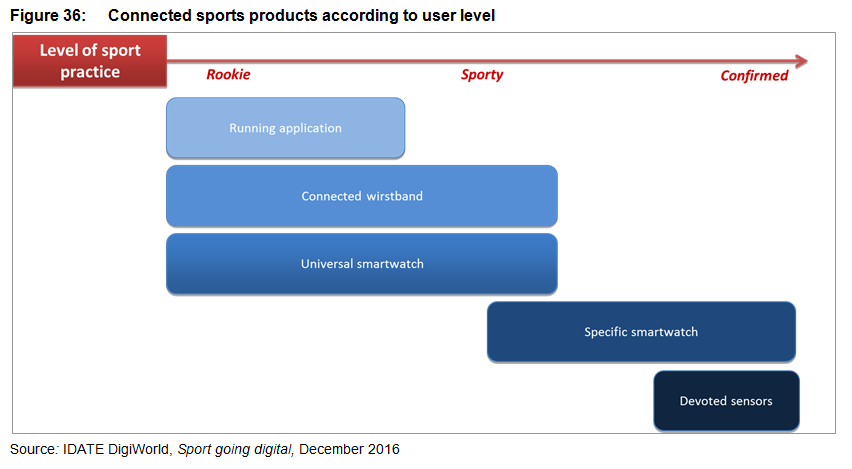In 2021, the installed base of sports-related connected objects should exceed 528 million units, versus 75 million in 2015, representing an annual average growth rate of 39% over the period.
From a market perspective, the climate seems favourable if we consider:
- the growing revenues from sport (+95% between 2005 and 2017);
- the constant increase in demand for components for wearables (USD 6 billion in 2018);
- the stable level of consumer demand for sports-related objects.

The connected sports market offers several advantages: a relatively broad target of individuals who practise sports, disciplines suited to social media which support the use of connected tools, a position in the health/well-being sector in which people are prepared to pay, and few technical constraints (mature technologies, limited mobilisation of telecom networks, etc.).
However, some constraints are slowing deployment: potentially prohibitive costs of the connected versions of products compared to their “traditional” version, limited battery life, the need to use additional accessories to access the network, issues concerning the security of personal data, fierce competition in the running sector, restricted markets for most sporting disciplines, as well as the risk of the market losing momentum once the “fad phenomenon” has passed (an abandonment rate of 33% after 6 months and 50% after 18 months).
Revenues today mainly come from the sale of objects. However, while the direct revenues generated are relatively low, the opportunities for data are considerable, as witnessed by the big sports equipment manufacturers and their acquisition of pure applications players. The information gathered from users is a vital reSource for R&D departments and helps develop the products and personalise the marketing effort based on athletes’ characteristics.
While the marketing channels currently focus on B2C, some brands are starting to adopt B2B2C distribution, taking advantage of CSR policies1 (providing tools for the well-being of employees) and insurance companies keen to flesh out their services with these types of tools to improve the health of customers and thereby reduce expenditure.
The big tech corporations like Apple and Google have developed data aggregation platforms, but their strategies differ. While Apple hopes to use this information to continue improving sales via its user data, Google sees it as a means of boosting the sales of its online advertising.
The connected sports market is becoming a major vertical sector of wearables. It remains a high-growth market which should see changes in terms of player positioning: some will leave the market and others will merge or form partnerships, etc. When the market starts to lose momentum, once the fad phenomenon is over, brands will be forced to devise new service models (coaching, video reconstruction, community challenges, games, etc.) primarily to continue gathering user data. In parallel, manufacturers should supplement their traditional B2C method of distribution with B2B2C marketing.
To delve deeper into connected sport market
check out our latest market report
More info
